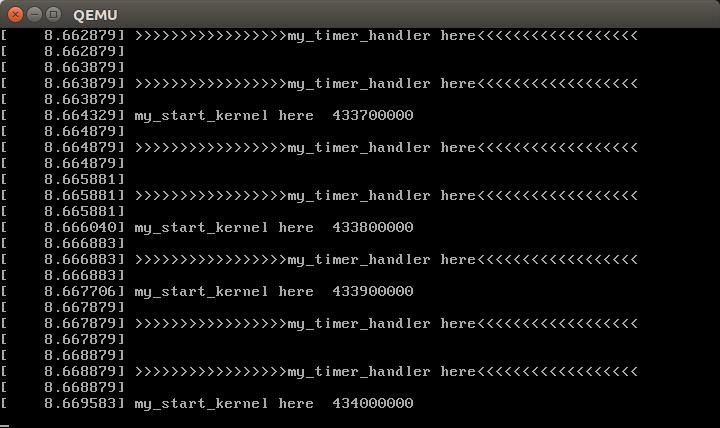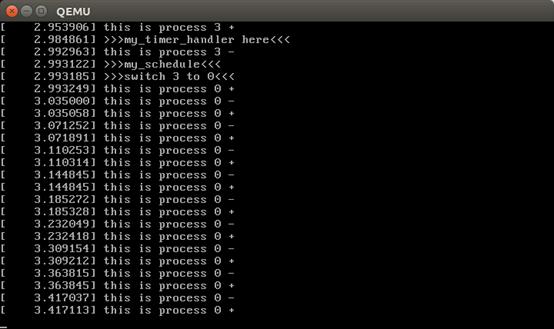基于mykernel 2.0编写一个操作系统内核
Posted liushu-ang
tags:
篇首语:本文由小常识网(cha138.com)小编为大家整理,主要介绍了基于mykernel 2.0编写一个操作系统内核相关的知识,希望对你有一定的参考价值。
1.实验要求
- 按照https://github.com/mengning/mykernel 的说明配置mykernel 2.0,熟悉Linux内核的编译;
- 基于mykernel 2.0编写一个操作系统内核,参照https://github.com/mengning/mykernel提供的范例代码;
- 简要分析操作系统内核核心功能及运行工作机制。
2.实验步骤
(本次实验在Ubuntu 16.0.4环境下进行)
2.1 安装和编译
首先根据 https://github.com/mengning/mykernel 中所说,输入以下命令下载 linux-5.4.34 和 mykernel-2.0_for_linux-5.4.34.patch,打上补丁并编译内核
注意路径可能有所不同
sudo apt install axel axel -n 20 https://mirrors.edge.kernel.org/pub/linux/kernel/v5.x/linux-5.4.34.tar.xz xz -d linux-5.4.34.tar.xz tar -xvf linux-5.4.34.tar cd linux-5.4.34 patch -p1 < ./mykernel-2.0_for_linux-5.4.34.patch sudo apt install build-essential libncurses-dev bison flex libssl-dev libelf-dev sudo apt install qemu make defconfig make -j$(nproc)
之后输入
qemu-system-x86_64 -kernel arch/x86/boot/bzImage
即可运行起内核,运行结果是一个不断循环的打印

进入mykernel文件夹下,能看到的C文件就是这两个:mymain.c 和 myinterrupt.c,打开mymain.c,可以看到如下一段代码
void __init my_start_kernel(void) { int i = 0; while(1) { i++; if(i%100000 == 0) pr_notice("my_start_kernel here %d \\n",i); } }
显然,在循环打印中,my_start_kernel here... ...这条消息是由进程运行mymain.c时进行打印的。再打开myinterrupt.c,能够看到如下代码
void my_timer_handler(void) { pr_notice("\\n>>>>>>>>>>>>>>>>>my_timer_handler here<<<<<<<<<<<<<<<<<<\\n\\n"); }
循环打印里的另一段就是由进程执行到此处打印的
mykernel能够周期性的产生时钟中断,中断处理程序就会调用my_timer_handler函数,调用完成后再返回到原来的上下文中(mymain.c的循环处),就会产生交替打印的效果。
2.2 完善内核的进程切换部分
在 https://github.com/mengning/mykernel 中,可以看到 mypcb.h 这一文件,即进程控制块相关。想要完善内核的进程切换,首先需要实现我们自己的进程控制块(此处直接copy的孟宁老师的代码)
#define MAX_TASK_NUM 4 #define KERNEL_STACK_SIZE 1024*2 /* CPU-specific state of this task */ struct Thread { unsigned long ip; unsigned long sp; }; typedef struct PCB{ int pid; volatile long state; /* -1 unrunnable, 0 runnable, >0 stopped */ unsigned long stack[KERNEL_STACK_SIZE]; /* CPU-specific state of this task */ struct Thread thread; unsigned long task_entry; struct PCB *next; }tPCB; void my_schedule(void);
可以看到进程拥有三种状态:unrunnable、runnable和stopped,每个进程都拥有自己的堆栈,并由ip、sp(对应eip寄存器和esp寄存器)进行控制。pcb块间以链表的形式串联起来
接下来修改mymain.c
#include <linux/types.h> #include <linux/string.h> #include <linux/ctype.h> #include <linux/tty.h> #include <linux/vmalloc.h> #include "mypcb.h" tPCB task[MAX_TASK_NUM]; tPCB * my_current_task = NULL; volatile int my_need_sched = 0; void my_process(void); void __init my_start_kernel(void) { int pid = 0; int i; /* Initialize process 0*/ task[pid].pid = pid; task[pid].state = 0;/* -1 unrunnable, 0 runnable, >0 stopped */ task[pid].task_entry = task[pid].thread.ip = (unsigned long)my_process; task[pid].thread.sp = (unsigned long)&task[pid].stack[KERNEL_STACK_SIZE-1]; task[pid].next = &task[pid]; /*fork more process */ for(i=1;i<MAX_TASK_NUM;i++) { memcpy(&task[i],&task[0],sizeof(tPCB)); task[i].pid = i; task[i].thread.sp = (unsigned long)(&task[i].stack[KERNEL_STACK_SIZE-1]); task[i].next = task[i-1].next; task[i-1].next = &task[i]; } /* start process 0 by task[0] */ pid = 0; my_current_task = &task[pid]; asm volatile( "movq %1,%%rsp\\n\\t" /* set task[pid].thread.sp to rsp */ "pushq %1\\n\\t" /* push rbp */ "pushq %0\\n\\t" /* push task[pid].thread.ip */ "ret\\n\\t" /* pop task[pid].thread.ip to rip */ : : "c" (task[pid].thread.ip),"d" (task[pid].thread.sp) /* input c or d mean %ecx/%edx*/ ); } int i = 0; void my_process(void) { while(1) { i++; if(i%10000000 == 0) { printk(KERN_NOTICE "this is process %d -\\n",my_current_task->pid); if(my_need_sched == 1) { my_need_sched = 0; my_schedule(); } printk(KERN_NOTICE "this is process %d +\\n",my_current_task->pid); } } }
新添加的my_start_kernel函数用来执行初始化工作。它初始化了MAX_TASK_NUM个进程控制块,然后内嵌了汇编代码,这段代码会把pid为0的进程的sp和ip写入寄存器
完善了mymain.c后,继续完善myinterrupt.c
#include <linux/types.h> #include <linux/string.h> #include <linux/ctype.h> #include <linux/tty.h> #include <linux/vmalloc.h> #include "mypcb.h" extern tPCB task[MAX_TASK_NUM]; extern tPCB * my_current_task; extern volatile int my_need_sched; volatile int time_count = 0; /* * Called by timer interrupt. * it runs in the name of current running process, * so it use kernel stack of current running process */ void my_timer_handler(void) { if(time_count%1000 == 0 && my_need_sched != 1) { printk(KERN_NOTICE ">>>my_timer_handler here<<<\\n"); my_need_sched = 1; } time_count ++ ; return; } void my_schedule(void) { tPCB * next; tPCB * prev; if(my_current_task == NULL || my_current_task->next == NULL) { return; } printk(KERN_NOTICE ">>>my_schedule<<<\\n"); /* schedule */ next = my_current_task->next; prev = my_current_task; if(next->state == 0)/* -1 unrunnable, 0 runnable, >0 stopped */ { my_current_task = next; printk(KERN_NOTICE ">>>switch %d to %d<<<\\n",prev->pid,next->pid); /* switch to next process */ asm volatile( "pushq %%rbp\\n\\t" /* save rbp of prev */ "movq %%rsp,%0\\n\\t" /* save rsp of prev */ "movq %2,%%rsp\\n\\t" /* restore rsp of next */ "movq $1f,%1\\n\\t" /* save rip of prev */ "pushq %3\\n\\t" "ret\\n\\t" /* restore rip of next */ "1:\\t" /* next process start here */ "popq %%rbp\\n\\t" : "=m" (prev->thread.sp),"=m" (prev->thread.ip) : "m" (next->thread.sp),"m" (next->thread.ip) ); } return; }
新增的my_schedule函数是处理进程调度的关键。上文已经说过,pcb块以链表的形式串联起来,my_schedule函数选择进程链表中的下一个就绪进程进行切换。它也内嵌了汇编代码,实现的功能如下:
-
保存进程rbp寄存器内的值
-
保存进程rsp寄存器内的值
-
更新寄存器rsp为next指向的新进程内的sp变量值,此时进行了进程间栈帧的转换
-
保存原进程rip寄存器内的值
-
更新寄存器rip为新进程的ip变量值,至此进程调度完毕,切换到了新进程运行
make clean,再make一遍,再次运行时能够看到完善后的效果

以上是关于基于mykernel 2.0编写一个操作系统内核的主要内容,如果未能解决你的问题,请参考以下文章